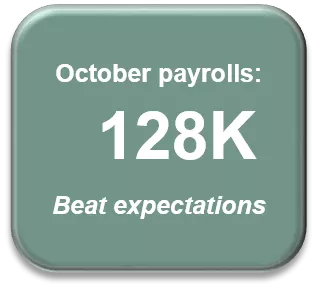November Economic Commentary: Pace of Expansion Slowing

Chief Economist
Pohlad Companies
The last week of October was filled with a number of significant economic reports as well as the Federal Reserve’s recent decision on the course of interest rates. Although the uncertainties related to the continuing Chinese trade tensions, Brexit, and a slowing global economy were frequently mentioned, the raw data suggests that the U.S. economy is still expanding, albeit at a reduced pace.
GDP Growth Slows
The initial reading of 3Q-19 real GDP showed the economy advancing at a 1.9% annualized growth rate, which is down from the 2.0% rate in 2Q-19. The year-over-year rate of growth slowed to 2.0%. Real GDP in the first half of 2019 advanced at a 2.6% annual rate, but indications are that the second half of 2019 will likely show growth closer to 1.8%.
Real GDP in 3Q-19 was mainly supported by consumer spending, which is the largest part of the economy. Consumer spending grew at a 2.9% rate, down from the 4.6% rate in 2Q-19. Contributions from the remainder of the economy were essentially nil in 3Q-19. Consumer spending is moderating, and the personal savings rate is near the upper end of its range of the past five years—indications that consumers are becoming more cautious. With American business reluctant to ramp up capital investment due to trade policy uncertainty and weak global demand, consumer spending in the U.S. (accounting for 70% of GDP) is the primary support for continued economic growth.
Lower Fed Funds Rate
The Fed lowered the target range for the Fed Funds rate from 1.75% - 2.00% to 1.50% - 1.75%. The Fed has lowered rates at each of their past three meetings. The Fed commentary suggests that they are now prepared to leave rates on hold for some time and assess the impact on the economy on a meeting-by-meeting basis. Chairman Powell indicated that the reductions in the Fed Funds rate should be viewed as insurance for an aging economic expansion imperiled by trade tensions and faltering global growth.

October Employment Report
The employment report released on Friday showed that payrolls in October grew by 128,000, better than estimated and the prior two months were revised up by a net 95,000. The unemployment rate ticked up to 3.6% from 3.5% as the size of the labor force increased by more than the gain in employment according to the household survey. The pace of hiring is slowing, reflecting a diminishing supply of qualified workers and some hesitancy to hire due to the slowing economy.
Average hourly earnings continued to grow at a steady, but unspectacular, rate with the year-over-year growth rate at 3.0%. The year-over-year rate of growth for earnings peaked in February at 3.4% and has been declining since then.
Manufacturing Weakness
Continuing weakness in the manufacturing sector was confirmed with the October PMI reading of 48.3, a slight improvement from September but the third consecutive month with a reading below 50, indicating contraction in the sector. So far, the weakness in manufacturing has yet to spread to the remainder of the economy, but this warrants continued attention.
Slow-Growth Economy
In short, the recent data paints a picture of a slowing—but not contracting—economy. A slow-growing economy is less prone to develop imbalances or generate substantial inflation pressures; however, reliance on a single support—the consumer—for ongoing growth leaves the economy more susceptible to extraneous shocks. Monitoring the ongoing health of the U.S. labor market, then, continues to be critical in assessing potential future economic activity.
Insights
Research to help you make knowledgeable investment decisions